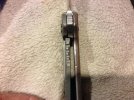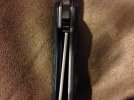I have been around a while and have a sort of general knowledge about knives but I see a term used here with regard to folders that I do not understand.
The phrase or term is often stated like this;
"blade is centered and lockup is 80%" or 'lockup is 50%'.
What does this mean?
I understand blade centering but not the percentage reference to lockup
The phrase or term is often stated like this;
"blade is centered and lockup is 80%" or 'lockup is 50%'.
What does this mean?
I understand blade centering but not the percentage reference to lockup
Last edited:



